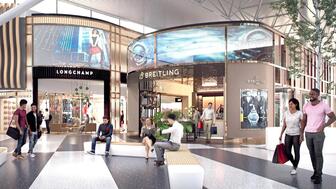It purchased the “Grosse Pièce,” an ultra-complicated Audemars Piguet pocket watch from the ‘20s, for a record-breaking price at Sotheby’s.
De Beers executives in America
For the first time in 70 years, De Beers’ executives entered the United States this week to conduct business, something they had been unable to do for the past seven decades due to anti-trust issues.
 On Tuesday night, the Diamond Manufacturers and Importers Association of America hosted a discussion with De Beers Group CEO Philippe Mellier, Varda Shine, CEO of Global Sightholder Sales for De Beers (formerly the Diamond Trading Co.), and Stephen Lussier, CEO of Forevermark, the company’s diamond brand.
On Tuesday night, the Diamond Manufacturers and Importers Association of America hosted a discussion with De Beers Group CEO Philippe Mellier, Varda Shine, CEO of Global Sightholder Sales for De Beers (formerly the Diamond Trading Co.), and Stephen Lussier, CEO of Forevermark, the company’s diamond brand.The following evening, I had the chance to conduct a one-on-one interview with both Mellier, whom I was meeting for the first time, and Lussier.
Below are highlights from Tuesday’s discussion as well as the interview conducted with Mellier and Lussier on Wednesday.
Mellier brings an outside perspective to De Beers. When he was hired in 2011, Mellier became the first diamond industry outsider to head the company, which dates back to 1888.
At the presentation on Tuesday night, he said that the industry needs to become a “normal luxury industry,” with more transparency and normal lending practices and liquidity. I followed up on this statement in our interview Wednesday night.
“One of the biggest things we need to work on is: If you are in the luxury industry you have to be customer-driven. You have to understand your customer,” Mellier said.
He said the diamond industry needs to behave like the shoe or handbag industry, both of which produce demand among their customers.
“This is a change we would like to lead,” Mellier said, a change that already is underway per the previously announced realignment. “This is the most fundamental change we are looking at.”
It is interesting that Mellier brought up shoes and handbags, as those are the luxury products that, along with electronics, most often are mentioned as taking market share away from diamonds, possibly because the marketing to the end consumer is better. (Apple, as one example, is genius at marketing its products.)
This leads us into my next main point: the need for generic marketing for diamonds.
De Beers is filling the generic marketing void with Forevermark. Going by what Lussier said at the presentation on Tuesday it seems that De Beers, to some extent, has given up on the idea of the industry pulling together to create a global, generic marketing campaign for diamonds.
I asked Lussier about this again on Wednesday.
“Clearly we are investing significantly behind the Forevermark,” he said.
The failed attempt at creating the International Diamond Board (IDB) a few years back showed that the industry was not capable of
While another attempt at creating an international body may be forthcoming, De Beers decided to move forward with Forevermark rather than wait years for something that, in the end, may or may not be accomplished.
The advertising for Forevermark serves two purposes: it calls attention to De Beers’ branded diamond and helps to prop up consumer demand for diamonds as a whole, Lussier said.
The biggest challenge for retailers today where diamonds are concerned is margin. Lussier said this both at Tuesday’s night presentation and in our one-on-one interview. I think you would find very little argument from our readers on this point.
On the Kimberley Process … Following our discussion about Forevermark serving as a vehicle to maintain consumer demand for diamonds, I asked Mellier and Lussier if Forevermark also was a way for De Beers to protect itself should the Kimberley Process (KP)--which has been on shaky footing for the past couple of years--crumble. Even if the process failed and consumer confidence took a nosedive, De Beers could point to Forevermark and say, “We have traced the origin of these diamonds from mine to market. We know they are not conflict diamonds.”
The answer was, essentially, no. “We are strong supporters of the Kimberley Process,” Mellier said. “We believe it is important the KP works and stays alive.”
Forevermark is De Beers’ diamond brand and has “nothing to do for or against the KP,” Mellier said.
The KP, both Lussier and Mellier pointed out, only was designed to deal with one specific issue. Even though an expanded definition is on the table, the KP works to keep “conflict” diamonds, diamonds used by rebel movements to fund wars against legitimate governments, out of the trade.
What they are saying with the Forevermark is that it has been traced from mine to market and is a responsibly sourced diamond along all aspects of the pipeline. It is meant to go “further and deeper” than the KP, which, Lussier said, has been relatively adept at dealing with the issues for which it was created. “(With Forevermark) you are trying to appeal to consumers who have a greater interest,” he said.
Establishing the De Beers Diamond Jewellers chain in the United States is proving to be a greater challenge than anticipated. Without any hard numbers, it is difficult to say how the chain is performing here, where it now has 44 doors, or to make projections about the future.
The chain is a 50/50 joint venture with Moët Hennessey Louis Vuitton (LVMH), which is a public company but only provides sales figures for business groups (i.e., Watches & Jewelry or Fashion & Leather Goods) not individual brands or stores.
During the presentation Tuesday, Lussier said they were a “bit naïve” about how challenging it is to build a retail chain and establish a brand from scratch.
“We’re learning to be a bit more patient about it,” he said.
He added that they are having more success in the Far East than they are in the United States because retail brands there are less established.
“It’s going to take time to establish a brand,” Mellier added on Wednesday. “I don’t think Cartier was created overnight.”
Just for the record: De Beers doesn’t want to start selling gem-quality synthetic diamonds. Lab-grown diamonds were in the news throughout 2012 and they came up during the executives’ visit as well.
Shine mentioned them in her presentation on Tuesday night and, that same night, Mellier said that the synthetic melee screening device developed by De Beers should hit the market by the third quarter.
So, I thought, why not ask: Does De Beers want to get into the business of selling synthetic diamonds and diamond jewelry? The answer was no.
Mellier said while there are a number of innovative applications underway at Element Six, De Beers’ synthetic diamond arm, they aren’t in the realm of diamond jewelry.
“It’s a good business for us but not for jewelry,” he said.
The Latest

Sponsored by Digital Monitoring Products

The boutique is slated to open this week inside Terminal 8, offering pre-owned Rolex watches and more to international travelers.

How Jewelers of America’s 20 Under 40 are leading to ensure a brighter future for the jewelry industry.

The lab-grown diamond grower now offers custom engagement and fashion jewelry through its Kira Custom Lab Jewelry service.


The special-edition egg pendant ingested in a New Zealand jewelry store was recovered after a six-day wait.

The “Love and Desire” campaign is inspired by the magic that follows when one’s heart leads the way, said the brand.

Roseco’s 704-page catalog showcases new lab-grown diamonds, findings, tools & more—available in print or interactive digital editions.

Two awardees will receive free tuition for an educational course at the Swiss lab, with flights and lodging included.

Berta de Pablos-Barbier will replace Alexander Lacik at the start of January, two months earlier than expected.

Sotheby’s held its first two jewelry sales at the Breuer building last week, and they totaled nearly $44 million.

Winners will receive free registration and lodging for its fourth annual event in Detroit.

Here are six ideas for making more engaging content for Instagram Reels and TikTok, courtesy of Duvall O’Steen and Jen Cullen Williams.

The honorees include a notable jewelry brand, an industry veteran, and an independent retailer.

Carlos Jose Hernandez and Joshua Zuazo were sentenced to life without the possibility of parole in the 2024 murder of Hussein “Sam” Murray.

Yood will serve alongside Eduard Stefanescu, the sustainability manager for C.Hafner, a precious metals refiner in Germany.

The New Orleans jeweler is also hosting pop-up jewelry boutiques in New York City and Dallas.

Set in a Tiffany & Co. necklace, it sold for $4.2 million, the highest price and price per carat paid for a Paraíba tourmaline at auction.

The jeweler’s “Deep Freeze” display showcases its iconic jewelry designs frozen in a vintage icebox.

Take luxury gifting to new heights this holiday season with the jeweler’s showstopping 12-carat sphene ring.

This year's theme is “Unveiling the Depths of the Ocean.”

In its annual report, Pinterest noted an increase in searches for brooches, heirloom jewelry, and ‘80s luxury.

Starting Jan. 1, customers can request the service for opal, peridot, and demantoid garnet.

The 111-year-old retailer celebrated the opening of its new location in Salem, New Hampshire, which is its third store in the state.

The new catalog features its most popular chains as well as new styles.

The filmmaker’s personal F.P. Journe “FFC” prototype was the star of Phillips’ recent record-setting watch auction in New York.

The new location in the Design District pays homage to Miami’s Art Deco heritage and its connection to the ocean.


























